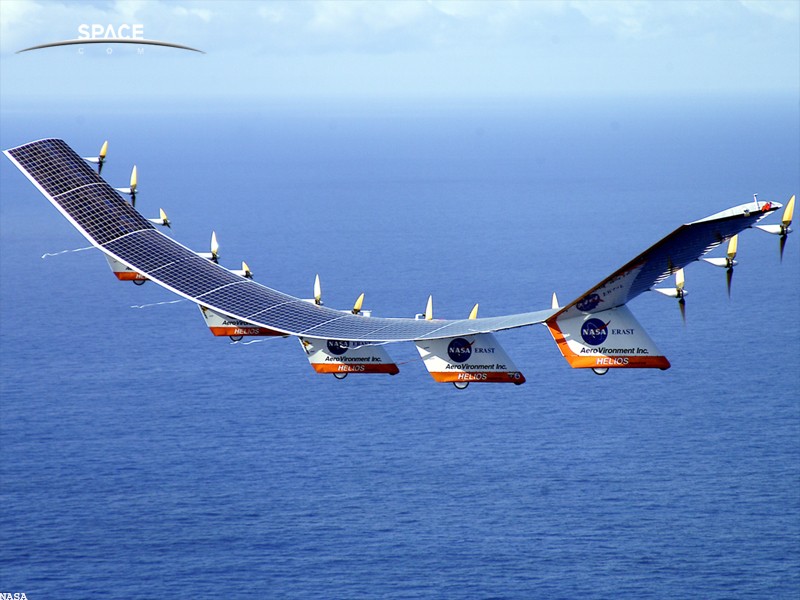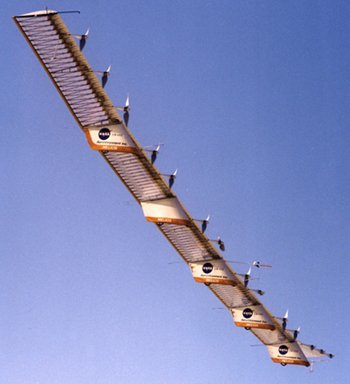Flying to the Edge of Air
Today, let us ride Helios' golden chariot. The University of Houston's College of Engineering presents this series about the machines that make our civilization run, and the people whose ingenuity created them.
Helios, Greek god of the sun, rode his golden chariot east to west each day. By night he floated, in a golden bowl, back to his palace in the East. Eos, goddess of the dawn, and Selene, goddess of the moon, were his sisters.
Small wonder that the AeroVironment Company gave the name Helios to a new craft it's built for NASA. This huge pilotless airplane is a creature of the sun. Helios' wingspan is almost the length of a football field. Each of its fourteen engines drives a propeller. Yet it weighs only four fifths of a ton -- less than most cars.
Helios is really little more than a long flexible wing. Its top is covered with solar panels, which gather all its energy from the sun. It carries no fuel and can stay aloft indefinitely. It will eventually serve as a poor man's geosynchronous satellite. Actually, it won't quite stay in the same spot over Earth's surface but will fly in a circle at around twenty miles an hour. By flying at a very high altitude, Helios will be able to serve the same functions as a communications satellite.

Schematic views of Helios, courtesy of NASA
 Helios set out from Kauai in the Hawaiian Islands before 9:00 AM on Monday, August 13, 2001. Just over seven hours later, it reached 96,500 feet. That was eighteen miles high and two miles beyond the previous record. At that altitude, atmospheric pressure is about a fiftieth of the value on Earth. That, by the way, is only about three times Mars' atmospheric pressure. Small aircraft of this type might, one day, be used to survey Mars.
Helios set out from Kauai in the Hawaiian Islands before 9:00 AM on Monday, August 13, 2001. Just over seven hours later, it reached 96,500 feet. That was eighteen miles high and two miles beyond the previous record. At that altitude, atmospheric pressure is about a fiftieth of the value on Earth. That, by the way, is only about three times Mars' atmospheric pressure. Small aircraft of this type might, one day, be used to survey Mars.
Helios returned to Earth in the early hours of the next morning. On the way down, its propellers acted as windmills to generate what battery power it needed. Later versions of Helios will break water into hydrogen and oxygen by day and re-burn those elements again by night to supply energy. Like Helios of myth, this Helios will also return each dawn to begin its ride once again.
While work on Helios has gone on in relative quiet for some time, we've seen its precursors in the evolution of very light aircraft. In 1986 Burt Rutan's Voyager carried two people around the world in one seven-day flight. Human-powered airplanes were also setting records by then. As early as 1979, the pedal-powered Gossamer Condor made it across the English Channel.
The first successful solar-powered airplane was a direct outgrowth of the Gossamer Albatross with its extremely light construction. In 1980, the Gossamer Penguin became first in a long series of purely-solar-panel-powered airplanes to carry a human being. The pilot, Janice Brown, weighed only a hundred pounds.
So, amid this world of rockets and jets we find a new frontier of flight. We are, once more, creating a birdlike intimacy with the air around us. As we enter the new millennium, flight is reclaiming some of its old grace and delicacy. We have again what we lost when we first put engines in wooden and canvas airplanes.
I'm John Lienhard, at the University of Houston, where we're interested in the way inventive minds work.
(Theme music)
You will find articles on Helios in most major newspapers for Tuesday, August 14, 2001.
See also the various fact sheets and other web pages put out by NASA's Dryden Flight Research Center. e.g.:
I am most grateful to Clay Creech in the Dryden Flight Research Center's Public Relations office for his patient counsel on this episode.
For an older program touching on these issues, see Episode 1437.

Another view of Helios in flight. Image courtesy of NASA